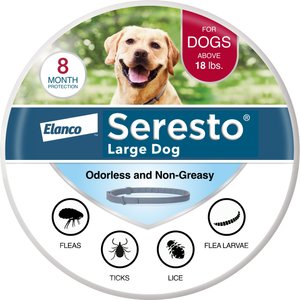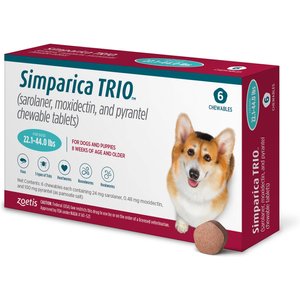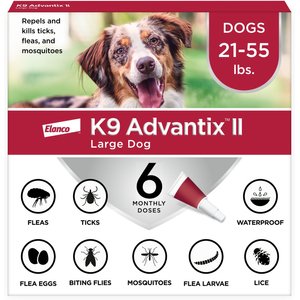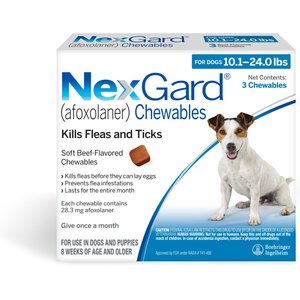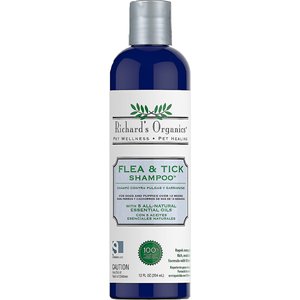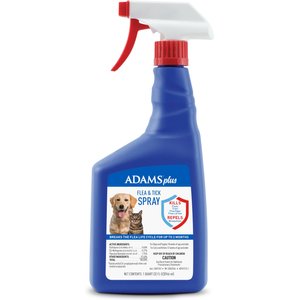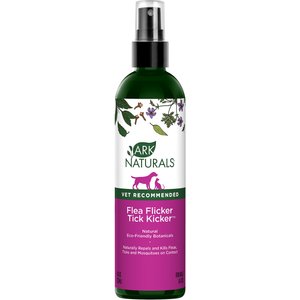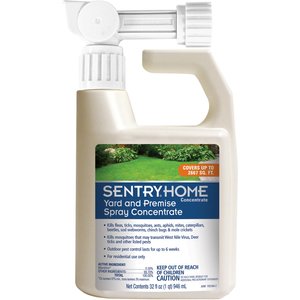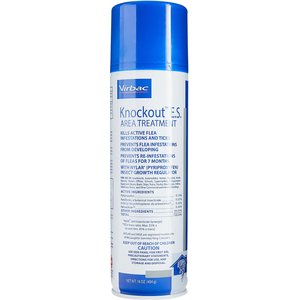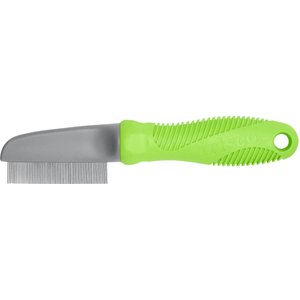Sometimes, the little things cause the biggest problems. Case in point? Fleas and ticks. Small but mighty, these notorious pests can wreak havoc on our four-legged friends, causing everything from itchy skin to serious medical conditions such as Lyme disease, anemia, Rocky Mountain spotted fever and more. But with the right flea and tick prevention for dogs, you can ensure your canine companion remains comfortable, healthy and parasite-free.
Ready to protect your pet? Read on for expert advice about how to choose the correct flea and tick prevention for dogs, as well as bestselling products recommended by doting pet parents (like you!).
-
1
Best Overall Flea and Tick Control for DogsSimparica Trio™ Chewable Tablet for Dogs, 6 Chewable Tablets (6-mos. supply) $195 on ChewyFREE 1-3 day shipping$195 on ChewyFREE 1-3 day shipping
-
2
$60 on ChewyFREE 1-3 day shipping
-
3
Best Topical Flea Treatment for DogsFrontline® Plus Flea & Tick Spot Treatment for Dogs $67 on ChewyFREE 1-3 day shipping$67 on ChewyFREE 1-3 day shipping
-
4
Best Flea and Tick Chewable for DogsNexGard® PLUS Chew for Dogs, 6 Chews (6-mos. supply) $214 on ChewyFREE 1-3 day shipping$214 on ChewyFREE 1-3 day shipping
-
5
$190 on ChewyFREE 1-3 day shipping
How To Find the Best Flea and Tick Treatment for Dogs
There’s no shortage of flea and tick treatments on the market today. So, how can you narrow things down and find the best option for your particular pup?
First thing’s first: Start with a conversation with your veterinarian. “I advise pet parents to look for flea and tick products that are approved and recommended by their veterinarian,” says Dr. Sara Ochoa, DVM, a veterinarian at Animal Hospital of West Monroe in Louisiana. “Products that vets trust have been thoroughly tested for safety.”
When selecting a product, you and your veterinarian will consider the following:
Your dog’s age: With the exception of very young puppies (under 8 weeks), as a general rule, almost all dogs should be on some type of flea and tick prevention. Elderly dogs with certain medical conditions may need to have their regimen adjusted, depending on their health; your veterinarian can advise if a new approach is needed.
Your dog’s overall health: Certain health conditions can affect which types of products are safest and most effective for your pet. Dogs with sensitive skin may need to avoid topical treatments, while dogs with food allergies may not tolerate oral treatments that include flavorings. For dogs with a history of seizures, your veterinarian may advise avoiding certain oral treatments that contain drugs in the isoxazoline class, which have been linked to neurological symptoms in some pets.
Your dog’s weight: Flea and tick treatments are dosed according to weight, with the weight range specified on the package. “Giving the wrong dose can lead to under- or over-dosing,” cautions Dr. Kong. “It’s essential to follow the product instructions carefully, and consult with a vet if there are any doubts.”
Your dog’s lifestyle: Your dog’s day-to-day activities may influence which type of product you select. For example, frequent swimmers may need to skip topical treatments, which require the dog to avoid getting wet for 24-48 hours. If your dog spends a lot of time outdoors in tick-heavy areas, your vet may recommend a combination of products for extra protection, such as a chewable and a collar.
Your lifestyle: Your household’s lifestyle may also influence the type of product you select. Families with young children may want to avoid topical medications, which can rub off on little hands. Similarly, flea collars may be tempting to curious toddlers.
Flea and tick treatment type: Treatments come in many different forms, from pills to topicals to collars. Some treat additional parasites. Some last months. All of these factors may play a role in your decision. (Read more about the different types below.)
14 Best Flea and Tick Treatments for Dogs
Below are the best flea and tick treatments for dogs as tested and approved by Chewy customers. These top-selling, top-rated products get two paws up from dog parents like you.
Best Overall Flea and Tick Control for Dogs
-
chewy makes it easy
Plus you can't beat the price anywhere else. It's so easy to order online and it is delivered to your home.
-
Does its job well
I have tried many different flea and tick items and this is the only one that works well with my two long hair shepherds!
-
This med is easy to give to my dog. So far she has not had any negative side effects and the med is working fine keeping her protected.
Best Flea Collar for Dogs
-
Seresto Flea Collar
We bought 4 of these collars and very pleased so far. Have not seen any fleas and we live in the country. I will definitely use them again, I don’t like topicals or chews maybe my dogs are getting older but they were having negative effects. This seems safer and effective as well. Glad I made the change.
-
Easy
I love the ease of ordering this online and not having to make a trip to the vets office. Not to mention is so much more affordable through Chewy.
-
Tick and flea collar
First service. Easy to order. Great product and it does what is supposed to do. I have 4 German Sheppards and not one get fleas and tick usingbthis collar. The collar does work for eight months like it says it will. Great product and Chewy is a great company.
Best Topical Flea Treatment for Dogs
-
Best Flea and Tick I Have Tried
Was using another brand a few years ago but didn't seem to be working. Frontline Plus Flea & Tick works very well.
-
Satisfied customer
We have been using Frontline for 7 years with our oldest, 2 yrs with the pup, and it has stood the test of time. We treat them every other month, and have not had a problem. We live in a rural/country setting, the dogs are running daily through field/wooded areas. It was an AMAZING deal, we got 8 doses for $75 which is crazy to me since I usually pay $50+ for just 3 doses. I really appreciate Chewy and the discounts/deals they offer on esstentials like this and would recommend them to anybody.
-
Good so far!
Applied 4/23... working well so far. Left some greasy residue behind as expected but disappeared within a few days, pretty satisfied.
Best Flea and Tick Chewable for Dogs
-
Worked great
My border collie has tried all of the combo meds and has got ill from them. This brand he was fine with it .
-
product is fine; Chewy service is great!
the product recommended/prescribed by my vet is fine. Each interaction I had with Chewy about the product or delivery was great--very efficient and friendly folks!
-
Good
Heart guard and more. I had to grind it in coffee bean grinder and mix with wet dog food. Only way she would eat it.
Best Dog Flea Pill
-
Chewy is the best
The package came speedily and in great shape. It was exactly as I ordered and on time. Our dog ate it with no problem and it seems to be working.
-
Quick response to a prescription problem
I was notified that my dog’s prescription had expired and I needed to contact my vet. I did and then notified Chewy what the doctor said. By this afternoon my prescription was on its way. Great response to my problem.
-
Med delivery
Ordered my dogs flea n tock med online n was so so easy!! They contacted my vet n it was shipped quickly!!
Best Over-the-Counter Flea and Tick Control for Dogs
-
Long term user
Been using for 4 years and not a flea, tick or mosquito bite. Very effective and really easy to apply.
-
Great product
My little guy will not take any of the chewable treatments, and a few of them made him sick. This works well and repels glues and other bugs as well.
-
Works Great
This is the best Flea and Tick treatment. I have always purchase it and have had many dogs. We live.in the country and have never had a problem as long as we used this. Is expensive but at least it works!
Best Flea and Tick Control for Puppies
-
Awesome
My orders are always fast,me hard is the best for dogs flea and tics,by the way Oscar is a Brussels Griffon
-
Heart guard & Next Guard
Our Three yr old Sweet baby (ABBY) is our Cocker Spaniel pup- She Stays both on Monthly -Next Guard And Heart Guard. We are beyond grateful and thankful because on one of her walks ( in Fl) - this winter she came home with a ( Dead) tick on her lower left eye lid after walking in one area of swampy grass. than goodness we had her on the preventative two meds First time Ever - to happen with any of our Four past pups Thank goodness for the prevention’s for Abby and do highly recommend But I am a RN not a doctor - so Talk to your Vet..
-
Please don't ever discontinue this flea medication. My dog ONLY likes this one. He won't eat the other ones at all. I love this option.
Best Flea Shampoo for Dogs
-
YES!
Love this stuff!! Not only for the flea and tick control, but my little guy smells soooo good! He’s also VERY soft and VERY shiny. We will continue to use this shampoo over and over.
-
Best Flea and Tick Shampoo
I use this even though our Schnauzer is on an oral Flea and Tick Prevention. We also use another skin care shampoo but I use this first since it lathers so well and has a nice scent.
-
Love This Stuff!!!
This stuff works so great and really does keep those darn fleas at bay. I have two pugs and it helps them out all spring through summer. They also sell a spray you can use in between bathing that just really adds an extra layer of protection. It's a must in my house and my pugs love it and smell amazing afterwards.
Best Flea Spray
-
I think it's good
Got it because my pet sitter told me my kittens were introduced to fleas, but turns out I didn't need it- didn't see any signs of fleas. Preemptively used it (sprayed on comb and brushed it in, because good luck spraying a cat) and so far, still no signs of fleas. Will keep in case.
-
We Love Adams
This is the best on-animal flea and tick spray out there! Dries quickly, pleasant scent, kills adult fleas and also prevents the eggs from hatching. Win-win!
-
THANK YOU ADAMS. THIS WORKS
I live in an area where fleas are infested in our sandy soil and ever since I moved here I have been battling fleas. I used all the Adams Flea care products together and I am happy to say that they have worked. My dog was anemic because of the flea infestation on him, in my home, and in my yard. I could never use oral medication because it caused him seizures. This is the only product that saved my little guy from dying from the fleas. Thank you Adams and Chewy.
Best With Heartworm Protection
-
Worked great
My border collie has tried all of the combo meds and has got ill from them. This brand he was fine with it .
-
product is fine; Chewy service is great!
the product recommended/prescribed by my vet is fine. Each interaction I had with Chewy about the product or delivery was great--very efficient and friendly folks!
-
Good
Heart guard and more. I had to grind it in coffee bean grinder and mix with wet dog food. Only way she would eat it.
Best Natural Flea and Tick Control for Dogs
-
It works for us
I have been using this product since the beginning of spring of this year 2023. This is our first spring and summer going all natural for flea control. Both my dogs are doing great with this spray, along with a monthly shower using a natural flea and tick repellant shampoo. It is now the end of summer, and I have not found a single flea or tick on my dog all summer, and we have even gone to the dog park several times! I do apply this spray every single day, at least once a day and sometimes twice. The dogs smell amazing. They smell clean and fresh. I will continue to use this product! So glad I don’t have to use chemicals on my dog!
-
This stuff seems to work
We don’t like using chemicals on our furry kids (8). We were on the verge of a flea infestation and started using this product especially on the dogs -EVERY time they go outside - and on the carpets (which get vacuumed at least once daily). We are under control. The next big adventure will be rubbing this into cat fur. The only negative is the little pump spray is less than dependable. I would suggest getting a good trigger spray and filling it with this product.
-
Great Find
I was looking for a good natural flea and tick spray and I have found one! It is a wonderful smell, but not too strong and my dog and I love it. Highly recommended!
Best for the Yard
-
Works as stated.
I've been using this product for 4 years, and I love it! I would recently it to anyone who needs to rid their yard of fleas, ticks, and lots of other pests.
-
Die, fleas, die!
We must've had our RV parked at Flea Central, and we saw a noticeable drop in the flea populations on our 2 cats and 1 dog after we sprayed this. Easy to use and effective.
-
Works as it says
Worked so far. While in yard, I didn't see any flying bugs nor did I get bit with no bug spray on. My dog isn't bringing in flea friends anymore. Im buying more of this
Best for the Home
-
Got rid of a problem
Living in the south fleas are an unavoidable problem sometimes and this time was a struggle. Roommate tracked them in and it was game over. I was moving to a new apartment and had to get them gone. I bought a can and it was able to cover all the carpets in my 2 bedroom and along with flea meds, baths and this preventative, the problem was gone! thank you so much
-
Loved it
We have five cats. That's A LOt of fleas when they get going. This was amazing. Washed and vacuumed sprayed this stuff on everything they laid on. Done. One week later, all gone, no fleas, not one on the comb. We did treat them as well. So much less then expensive and a great product thank you!
-
Flea house spray
I use this spray when I determine I have a flea outbreak, preferably at the 1st sighting. It does the job! I keep my pets out of the room
Best Flea Comb
-
An inexpensive must-have for your eye booger arsenal.
Full disclosure: I bought this flea comb simply because I needed to add a $2 item to my cart to receive free shipping on a recent order. We've all been there. But now I use this little comb every day to battle eye boogers in my Yorkies! After softening the eye crust with a moist cleaning pad, I use this tiny-toothed tool to carefully comb the debris away. Having a handle on a flea comb adds comfort, yet at 7" overall length, it's still small enough for delicate control around the eyes. And unlike other inexpensive combs, these teeth seem pretty high quality, gently rounded and not sharp to the touch at all. A very good buy for boogers!
-
A Great Comb!
This comb is high quality and very sturdy. I'm thinking of ordering a second comb to keep in a different room. I love to use the comb to brush my kitties.
-
Great for crusty white dogs
I have a maltipoo who cries a lot due to her eyes problem that cause her to blink more. This helps in cleaning her face and neck easier and faster than the slicker brush. I also like to brush her problem areas like arm pits, feet and belly with this.
Types of Flea and Tick Medications
Generally speaking, all dogs should be on a year-round flea and tick regimen.
“In my professional opinion, all dogs should be on some form of flea and tick prevention,” Dr. Ochoa says. “Any dog can pick up these pests, regardless of breed, age or lifestyle, so having a preventative in place is crucial for every pup.”
Fortunately, there’s no shortage of options to protect your pet.
Topical Flea Treatments
Available both OTC and by prescription, topical solutions (also known as spot-on treatments) typically kill ticks, adult fleas, flea eggs and flea larvae, while also repelling them. Some medications also protect against other parasites, including hookworms, roundworms, ear mites and parasites that cause mange. Most topical treatments provide a month of protection and should be applied between your pup’s shoulder blades, where they’ll be unable to lick it off.
“I recommend continuing year-round prevention to keep your dog protected during flea and tick season,” says Dr. Ochoa. “But even with preventatives, the occasional pest can still sneak through, so check your dog regularly.”
Best for: Dogs who don’t like taking oral medications; dogs with food allergies; killing all life cycles and life stages of fleas; providing protection against other parasites
Oral Flea Treatments
A popular alternative to topical treatments, oral medications are formulated to treat flea infestations quickly, making them ideal for dogs with active infestations. For example, Capstar Tablets begin killing fleas within 30 minutes and provide 24 hours of protection; other chewables, such as NexGard, take a little longer to kick in but provide up to 30 days of coverage. Some chewables, such as Simparica Trio, also protect against heartworms. These treatments are available OTC and by prescription, and are particularly effective for water-loving dogs.
“Chewables can be a good option for dogs who frequently swim or bathe, as water exposure does not diminish their effectiveness,” says Dr. Sabrina Kong, DVM, Certified Canine Rehabilitation Practitioner at Jules Veterinary Center in Tracy, California.
Best for: Dogs with sensitive skin; dogs with an active flea infestation; households with young children or other pets who may interfere with topical medications or collars; dogs who swim or bathe frequently
Flea Collars
Although not as popular as oral or topical treatments, flea collars can be a great solution for some pets. Sold OTC, these collars quickly kill fleas and ticks on contact, as well as repel the pests from landing on your dog. Collars tend to last longer than other preventives, making them an attractive option to pet parents who have trouble remembering to administer monthly medications.
“Collars can offer longer-term protection, up to several months, but their effectiveness can vary depending on the product,” says Dr. Kong.
Before selecting a collar, check with your veterinarian to ensure that it’s a quality brand that will adequately protect your pet.
Best for: Dogs who don’t like taking medications orally; pet parents who prefer a longer-lasting option; budget-conscious pet parents
Flea Shampoos
Medicated flea shampoos kill fleas on contact; some formulas also repel fleas in the following weeks, as well as prevent eggs and larvae from maturing into adult fleas. Flea shampoos usually include therapeutic ingredients such as oatmeal and aloe to soothe irritated skin. Because flea shampoos typically provide protection for only two weeks, they’re not usually recommended as a primary source of flea control. However, they can be a helpful short-term solution for pets experiencing an active infestation.
Best for: Dogs who actively have fleas; dogs (and dog parents!) who enjoy bath time; killing active fleas quickly
Flea Sprays
Flea sprays are a budget-friendly way to kill active fleas and ticks, as well as to prevent new pests from taking up residence on your pet. Conveniently, many formulas can also be used around the house and yard to target areas that harbor pests. However, there are some drawbacks: Sprays need to be applied frequently (as often as every two days) and some may irritate your dog’s eyes and nose. If you want to incorporate flea sprays into your treatment plan, consult your veterinarian about how to best use them.
Best for: Dogs who have an active infestation; pet parents who want to treat parts of the house and yard
How To Get Rid of Fleas and Ticks on Your Dog
If your dog actively has fleas or ticks, you’ll want to get rid of the current infestation, as well as prevent another one from recurring. This requires a multi-step approach:
- Comb your dog with a flea comb, starting at the head and working your way to the tail. Place the removed fleas in a bowl of isopropyl alcohol to kill them.
- Bathe your dog with a flea shampoo after using the flea comb. If your dog has a severe case, consult your vet first to ensure the product is appropriate to use on irritated or damaged skin.
- Use a flea and tick prevention treatment and stick to the schedule. If you’ve lapsed on regular treatments, now is your time to get back on board!
Getting rid of fleas takes work, but it’s possible with a little expertise and effort. Check out this step-by-step guide with expert tips.
How To Get Rid of Fleas and Ticks From Your Yard and Home
If your pet has fleas, there’s a good chance the little buggers are also getting cozy in your home and yard. To permanently evict them, consider:
- Washing all bedding in hot, soapy water
- Vacuuming rugs, carpets and upholstery frequently, using a flea spray as necessary
- Vacuuming hard surfaces frequently, concentrating on areas near food bowls and pet beds
- Treating your yard with flea spray or hiring a pest management company
For more tips on flea prevention in the home, consult our down-and-dirty cleaning guide.
How We Chose These Products
We know fleas and ticks can be stressful. That’s why we rounded up these best-of-the-best products, as chosen by satisfied Chewy customers. Backed by thousands of ratings and reviews, these bestsellers have at least a 4-star rating and have proven themselves to be effective, trusted tools in keeping dogs happy, healthy and pest-free.
Talk to Your Veterinarian
Every dog is an individual, and every dog responds to fleas, ticks and treatments differently. If you have any concerns about your dog’s health, medications or side effects, check in with your veterinarian and work together to devise a personalized plan for your one-of-a-kind pup.
Flea and Tick Prevention for Dogs FAQs
Q: What are the signs of fleas and ticks on dogs?
A: Signs of fleas include intense itching, scratching and biting; hot spots; restlessness; hair loss; and, in severe cases, pale gums. Signs of ticks include licking and chewing; inflamed skin, scabs; head shaking (if the tick is in an ear); and, in rare cases, paralysis.
Q: What instantly kills fleas and ticks on dogs?
A: Flea shampoos and flea sprays kill fleas and ticks on contact. You can also use a flea comb to find and kill fleas instantly. Some chewable treatments, such as Capstar, kick in quickly, killing fleas in as little as 30 minutes.
Q: How does flea and tick medicine work?
A: Topical treatments are absorbed through the dog’s skin, killing fleas and ticks on contact. Oral preventives are swallowed and absorbed into the dog’s bloodstream; adult fleas and ticks die after biting the dog and ingesting the pesticide.
Q: Are there home remedies to treat and prevent fleas and ticks?
A: There are some home remedies—including Dawn dish soap, lemon, apple cider vinegar and baking soda—that may help to kill or temporarily repel fleas and ticks. However, even natural flea treatments can irritate the skin or cause serious health problems if used incorrectly. Consult your veterinarian before trying any home remedy.
Flea and Tick Control: Next Steps
Fleas and ticks are no fun, for pets or pet parents. Fortunately, there are a number of effective treatments available to eliminate and prevent infestations—and the more you know, the better prepared you are to keep your pet pest-free! Ready to learn more? Check out these 10 telltale (and surprising!) signs of fleas.
Expert input provided by Dr. Sara Ochoa, DVM, a veterinarian at Animal Hospital of West Monroe in Louisiana, and Dr. Sabrina Kong, DVM, Certified Canine Rehabilitation Practitioner at Jules Veterinary Center in Tracy, California, and veterinary consultant at WeLoveDoodles.com.
Learn more about protecting your pets from fleas:
Share:


